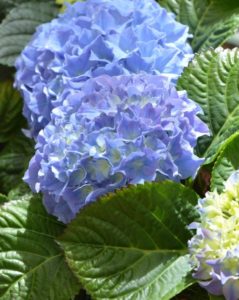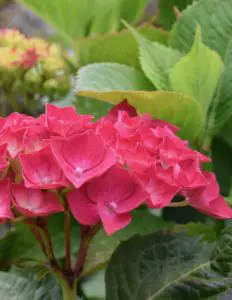Some links in the post are affiliate links and I get a commission from purchases made through some links found in the post.
Hydrangeas are one of the most beautiful ornamental shrubs. They are especially gorgeous during the growing season when breathtakingly colorful blooms appear.
Hydrangeas are actually very easy to care for and sometimes, the challenge is that they grow too fast. Therefore, many owners wonder if it is possible to split a hydrangea when it grows too large?
You can split a hydrangea when it overgrows. By doing so, you will receive two new plants from one mother’s body.
Generally, splitting is one of the most widely used propagation methods in shrubbed plants.
However, some species of hydrangeas such as climbing are recommended to be propagated from the cutting rather than splitting.
It is possible to split a hydrangea, however, you will need to know how to do it properly. Additionally, not all hydrangea species like to be split.
When splitting a hydrangea you need to make sure you have watered your hydrangea well the day before and afterwards.
To split the hydrangea, dig up your hydrangea, find the root ball and then slice it your shovel or pitchfork, this should be done in early spring.
No worries, in this article, we will walk you through the propagation process of hydrangea and give you some tips to keep your plant happy and healthy.
What Varieties of Hydrangea can be Split
 As already mentioned above, not all species of hydrangeas can be split. Some will not be able to withstand the division and will die.
As already mentioned above, not all species of hydrangeas can be split. Some will not be able to withstand the division and will die.
Therefore, it is essential to know which species can be split. For example, if you have Panicle Hydrangeas, they only come with one major trunk and are hard to cut evenly.
Additionally, any other type of climbing hydrangeas, that have tall vines most likely can not be splitted.
The species like Smooth Hydrangeas and Biglead will be fine with splitting because they are shrubs and have varieties of clusters. These multiple separations make it relatively easy to split a hydrangea and propagate it.
Can you Split a Hydrangea?
You can split a hydrangea and by doing so, you will not bring any harm to your favorite plant. Hydrangeas are shrubs that have junction points in the root system.
Their roots are designed like a ball and all this makes it possible for them to be propagated by splitting. Even by observing, you will see where those clusters may be.
Mostly, they are where the clumps get merged and if you look carefully at its base, you will eventually get where to aim.
If hydrangea has been in the same spot for a long amount of time, it will be a little hard to divide it, and wise versa, if it has been recently moved to its current spot, then it is very easy to split a hydrangea.
If newly bought hydrangeas have properly developed roots, they can even be separated and unrooted with bare hands.
The trickiest thing is splitting adult hydrangea, However, it is not impossible. As hydrangeas age, their roots get tougher, and is a little more difficult to separate them.
The young hydrangeas are best to split because they have not spread the roots yet and the root ball is not fully developed.
What are the Advantages of Splitting a Hydrangea?
Split of hydrangeas is actually very beneficial for the plant and for you. There are several advantages that come with dividing your beloved plant.
If you have a hydrangea in the container, then the roots can be bound to each other when they can not find any more space to grow.
They form like a ball and therefore, are limited in space. Hydrangeas grow very fast and their root system can get outgrown pretty quickly too.
Therefore, it is better for the health of the plant to be split. The division will give separate parts more air, space, and available nutrition.
Another reason why you should split a hydrangea is the space. When they grow aggressively, they sometimes get crowded and can shade other plants. Therefore, by splitting it, there will be more free space and it will benefit you and your plants.
Additionally, getting a new plant can be connected with additional costs. If you split a hydrangea, it will save you some costs and will give you the possibility to have several bushes of hydrangeas in your garden.
What Equipment you will Need to Split your Hydrangea
Each hydrangea plant is unique and they have individual characteristics. Therefore the equipment that you need is entirely dependent on how firmly the plant’s root system is established and how mature the hydrangea plant is.
If you have a hydrangea plant located in a pot or container, most likely their root system will not be too complicated and it will be possible to even split a hydrangea either with the hand the only thing you will need is garden gloves.
However, when you have a hydrangea in the garden, some additional tools may assist you in the process.
The tools include:
Shovel,
Pitchfork,
Rope or Twine,
Watering can or hose,
Garden clippers or shears,
Mulch, and
Some topsoil.
If the hydrangea is very old and well established, those may not be enough and additionally, a pick or axe can be needed.
What Time of Year Should you Split a Hydrangea?
 The most important element that needs to be considered when splitting the hydrangea is the correct timing. Those gorgeous plants can be divided either in the spring before the new growth appears or in the autumn.
The most important element that needs to be considered when splitting the hydrangea is the correct timing. Those gorgeous plants can be divided either in the spring before the new growth appears or in the autumn.
This is the period of their dormancy and therefore, the splitting will not stress the plant that much.
Also, in the fall, the leaves are already dried and fallen, which does not require any additional energy and all their power will be aimed at the development of new plants.
You must not split a hydrangea in summer. This is the blooming season for them and the whole energy of the plant goes into the flowers and growth.
The roots stay to be vulnerable and if split, will not be able to revive quickly. Therefore, the plant will stress and be harmed.
How to Split your Hydrangea
In order to split the hydrangea, you have to make sure that the plant has two stems at least. The stems must be coming from the main root.
In most cases, when the hydrangea plants grow, It has one main stem. The small offshoots grow from this one and all this happens on the ground level. When the hydrangea has those little offshoots, it is perfect for the splitting.
Now, we will discuss how to split a hydrangea step by step. First of all, the day before you are planning to split a hydrangea, and water and soak it well.
If you tile libs with the rope or twine, it will make the splitting process simpler by creating sections. This not only makes the transition of the plant easier but also will keep the stems and roots contained just as it was.
The second step is to dig up the root ball by use of a shovel. A shovel will give a possibility to do deep sharp cuts and also will loosen up the roots.
Make sure not to hit the roots with the shovel. The roots must be dug 2 feet under the main stem. Take out the roots carefully. Remember that if the hydrangea is old and big, the root system can be very heavy.
The next step is to divide the roots. larger and deeper the roots are, the more healthy the hydrangea plant seems to be. You can use a shovel and pitchfork to carefully divide the root ball.
There can be as many sections as the plant provides. You can split a hydrangea by putting the shovel blade in the middle of the root ball and sticking it in with the pressure.
Try to aim in the middle, so you get the same sized root balls from the mother root.
If you want to get more parts, what you can do is split the center into two parts and then split those two parts into smaller pieces. It is always better to device the root ball into either two or four pieces, as long as the plant makes it possible.
How to Replant the New Hydrangea
After you divide the plant’s root system, it is time for replanting. It is always better to plant the split hydrangea when the sun is not burning.
Make a little hole and fill it with water. The hole depth has to be approximately the same as the hole that was left after digging up the mother roots.
Also, you’ll need to loosen the soil that is around a little bit so the new roots have the ability to move around and grow quickly. Then put the root ball in the hole.
The newly planted hydrangea splits can be covered with topsoil and organic matter such as manure or compost so proper nutrition is provided.
The soil has to reach the stem the same way it did in the original plant. It is not recommended to plant your hydrangea splitting deeper.
After you plant your new hydrangea, add some water to hydrate it well with the slow drip method for a couple of hours.
The plant foliage and stems will droop most likely for the first few days because of its adjustment phase. The new hydrangeas will require more water because the roots need to be fed more.
There you go, if you do everything according to the instructions, your hydrangea splitting will thrive and give you beautiful flowers in summer.
Final Thoughts
 Hydrangeas are like a diva of plants. They are beautiful and grow pretty fast. When this beautiful bush gets overcrowded, it is time to separate it.
Hydrangeas are like a diva of plants. They are beautiful and grow pretty fast. When this beautiful bush gets overcrowded, it is time to separate it.
The separation can be done with splitting. After they are divided, both parts will be good for propagation and will provide a new plant.
Remember that not all hydrangeas like to be propagated by splitting and some species will not survive it. Therefore, those ones can be propagated from their cuttings.
Newly planted hydrangeas will require some more attention and care, however, once they get used to the new soil and environment, will eventually become happy and beautiful.


